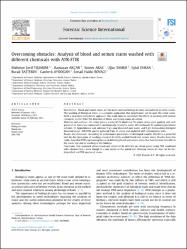Overcoming obstacles: Analysis of blood and semen stains washed with different chemicals with ATR-FTIR

Göster/
Erişim
info:eu-repo/semantics/embargoedAccessTarih
2023Yazar
Yıldırım, Mahmut ŞerifAkçan, Ramazan
Aras, Sümer
Tamer, Uğur
Evran, Eylül
Baştekin, Burak
Aydoğan, Canberk
Boyacı, İsmail Hakkı
Üst veri
Tüm öğe kaydını gösterKünye
Yildirim, M. Ş., Akçan, R., Sümer, A. R. A. S., Tamer, U., Evran, E., Taştekin, B., ... & Boyaci, İ. H. (2023). Overcoming obstacles: Analysis of blood and semen stains washed with different chemicals with ATR-FTIR. Forensic Science International, 344, 111607.Özet
Introduction: Blood and semen stains are the most common biological stains encountered at crime scenes. The washing of biological stains is a common application that perpetrators use to spoil the crime scene. With a structured experiment approach, this study aims to investigate the effects of washing with various chemicals on the ATR-FTIR detection of blood and semen stains on cotton.
Materials and methods: On cotton pieces, a total of 78 blood and 78 semen stains were applied, and each group of six stains was immersed or mechanically cleaned in water, 40% methanol, 5% sodium hypochlorite solution, 5% hypochlorous acid solution, 5 g/L soap dissolved pure water, and 5 g/L dishwashing detergent dissolved water. ATR-FTIR spectra gathered from all stains and analyzed with chemometric tools.
Results and discussion: According to performance parameters of developed models, PLS-DA is a powerful tool for discrimination of washing chemical for both washed blood and semen stains. Results from this study show that FTIR is promising for use in detecting blood and semen stains that have become invisible to the naked eye due to washing of the findings.
Conclusion: Our approach allows blood and semen to be detected on cotton pieces using FTIR combined with chemometrics, even though it is not visible to the naked eye. Washing chemicals also can be distinguished via FTIR spectra of stains.
Kaynak
Forensic Science InternationalBağlantı
https://dx.doi.org/10.1016/j.forsciint.2023.111607.https://hdl.handle.net/20.500.12933/1479















